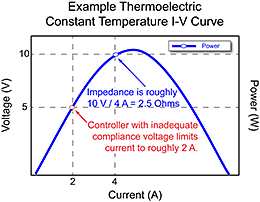Question
What does the Compliance Voltage specification in temperature controllers mean?
Answer
All of our controllers, except for the RHM controllers, are current sources. This means the current level is the focus of the control system. The voltage across the output device (thermoelectric) will develop according to Ohm’s Law:
Voltage = Current * Impedance
The voltage varies with the resistance of the load. The current source does not force a particular voltage across the output device. The compliance voltage specification indicates the maximum voltage that can be provided to the output device at full current, not the voltage that will be delivered.

For example, when driving a thermoelectric, the impedance can be estimated by the constant temperature V-I curve (see image above). If your thermoelectric needs 10 V at 4 A, then its impedance is roughly 2.5 Ohms (10 V / 4 A). If the controller can only provide up to 5 V at 4 A, the output will be Compliance Voltage limited. Again, Ohm’s Law rules. 5 V = IMAX * 2.5 Ohms; so IMAX would be limited to about 2 A. Pick a controller or driver with a compliance voltage large enough to support your output device at the desired operating current.
When specifying thermoelectric coolers or resistive heaters, verify that the maximum voltage is less than the compliance voltage of the temperature controller you are using. If you don’t match the thermoelectric cooler and the compliance voltage of the temperature controller, you might not be able to operate the thermoelectric to its full capabilities.
When using an OEM driver, the power supply is not included. The compliance voltage is dependent on what voltage power supply is chosen.
For product-specific information regarding compliance voltage, see the datasheet for that product. A more general overview of compliance voltage is given in the Application and Technical Notes below.

